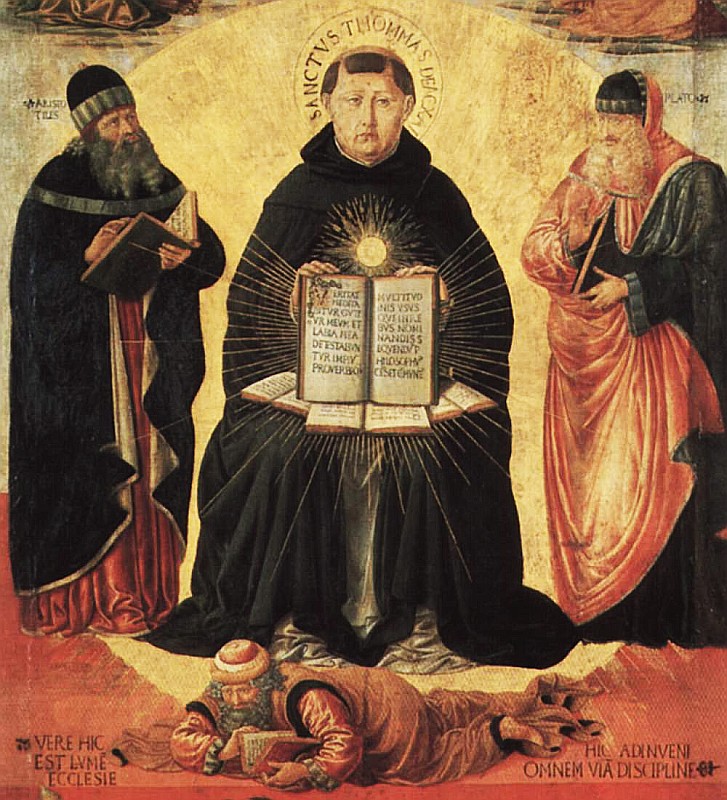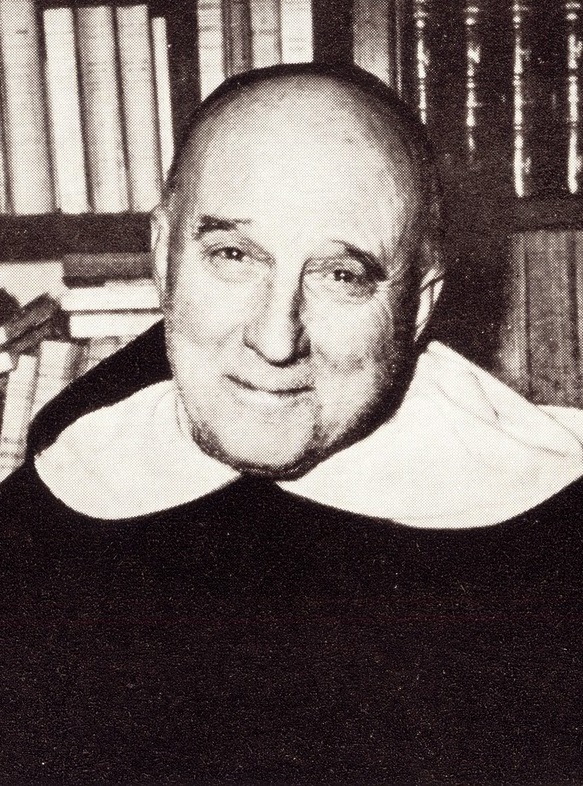Online source: www.breviary.net.
 Siena Cathedral | |
Absolutio: Ipsíus píetas et misericórdia nos ádjuvet, qui cum Patre et Spíritu Sancto vivit et regnat in sæcula sæculórum.R. Amen. | Absolution: May his loving-kindness and mercy assist us. Who, with the Father, and the Holy Ghost, liveth and reigneth, for ever and ever. R. Amen. |
V. Jube domne, (Dómine) benedícere. | V. Vouchsafe, Reverend Father (O Lord), thy blessing. |
Benedíctio 4: Deus Pater omnípotens sit nobis propítius et clemens. R. Amen. | Benediction 4: May God the Father Almighty shew us his mercy and pity. R. Amen. |
| Lesson iv | |
 Siena, where St. Catherine was born in 1347 | |
Catharína, virgo Senénsis, piis orta paréntibus, beáti Domínici hábitum quem soróres de Pœniténtia gestant, impetrávit. Summa ejus fuit abstinéntia et admirábilis vitæ austéritas. Invénta est aliquándo a die Cínerum usque ad Ascensiónem Dómini jejúnium perduxísse, sola Eucharístiæ communióne conténta. Luctabátur quam frequentíssime cum dæmónibus, multísque illórum moléstiis vexabátur ; æstuábat fébribus, nec aliórum morbórum cruciátu carébat. Magnum et sanctum erat Catharínæ nomen, et úndique ad eam ægróti et malígnis vexáti spirítibus deducebántur. Languóribus et fébribus in Christi nómine imperábat, et dæmones cogébat ab obséssis abíre corpóribus. | Catherine was a maiden of Siena, and was born of godly parents. She took the habit of the Third Order of St. Dominic. Her fasts were most severe, and the austerity of her life wonderful. It was discovered that on some occasions she took no food at all from Ash Wednesday till Ascension Day, receiving all needful strength by taking Holy Communion. She was engaged oftentimes in a wrestling with devils, and was sorely tried by them with divers assaults : she was consumed by fevers, and suffered likewise from other diseases. Great and holy was the name of Catherine, and sick folk, and such as were vexed with evil spirits were brought to her from all quarters. Through the Name of Christ, she had command over sickness and fever, and forced the foul spirits to leave the bodies of the tormented. |
V. Tu autem, Dómine, miserére nobis. R. Deo grátias. | V. But thou, O Lord, have mercy upon us. R. Thanks be to God. |
 | |
R. Propter veritátem, et mansuetúdinem, et justítiam : * Et dedúcet te mirabíliter déxtera tua, allelúja. V. Spécie tua et pulchritúdine tua inténde, próspere procéde, et regna. R. Et dedúcet te mirabíliter déxtera tua, allelúja. | R. Ride on because of the Word of truth, of meekness, and righteousness : * And thy right hand shall teach thee terrible things, alleluia. V. In thy comeliness, yea, in thy beauty, go forth, ride prosperously, and reign. R. And thy right hand shall teach thee terrible things, alleluia. |
 The Home of St. Catherine of Siena is now a museum | |
V. Jube domne, (Dómine) benedícere. | V. Vouchsafe, Reverend Father (O Lord), thy blessing. |
Benedíctio 5: Christus perpétuæ det nobis gáudia vitæ.R. Amen. | Benediction 5: May Christ bestow upon us the joys of life eternal. R. Amen. |
| Lesson v | |
 | |
Cum Pisis immorarétur, die Domínico, refécta cibo cælésti et in éxtasim rapta, vidit Dóminum crucifíxum magno cum lúmine adveniéntem, et ex ejus vúlnerum cicatrícibus quinque rádios ad quinque loca sui córporis descendéntes ; ideóque, mystérium advértens, Dóminum precáta ne cicatríces apparérent, contínuo rádii colórem sanguíneum mutavérunt in spléndidum, et in formam puræ lucis pervenérunt ad manus, pedes et cor ejus ; ac tantus erat dolor, quem sensibíliter patiebátur, ut nisi Deus minuísset, brevi se créderet moritúram. Hanc ítaque grátiam amantíssimus Dóminus nova grátia cumulávit, ut sentíret dolórem illápsa vi vúlnerum, et cruénta signa non apparérent. Quod ita contigísse cum Dei fámula confessário suo Raymúndo retulísset, ut óculis étiam repræsentarétur, rádios in imagínibus beátæ Catharínæ ad dicta quinque loca pertingéntes, pia fidélium cura pictis colóribus expréssit. | While she dwelt at Pisa, on a certain Lord's Day, after she had received the Living Bread which came down from heaven, she was in the spirit ; and saw the Lord nailed to the Cross advancing towards her. There was a great light round about him, and five rays of light streaming from the five marks of the Wounds in his Feet, and Hands, and Side, which smote her upon the five corresponding places in her body. When Catherine perceived this vision, she besought the Lord that no marks might become manifest upon her flesh, and straightway the five beams of light changed from the colour of blood into that of gold, and touched in the form of pure light her feet, and hands, and side. At this moment the agony which she felt was so piercing, that she believed that if God had not lessened it, she would have died. Thus the Lord in his great love for her, gave her this great grace, in a new and twofold manner, namely, that she felt all the pain of the wounds, but without there being any bloody marks to meet the gaze of men. This was the account given by the handmaiden of God to her Confessor Raymund, and it is for this reason that when the godly wishes of the faithful lead them to make pictures of the blessed Catherine, they paint her with golden rays of light proceeding from those five places in her body which correspond to the five places wherein our Lord was wounded by the nails and spear. |
V. Tu autem, Dómine, miserére nobis. R. Deo grátias. | V. But thou, O Lord, have mercy upon us. R. Thanks be to God. |
 | |
R. Dilexísti justítiam, et odísti iniquitátem : *Proptérea unxit te Deus, Deus tuus, óleo lætítiæ, allelúja.V. Propter veritátem, et mansuetúdinem, et justítiam. R. Proptérea unxit te Deus, Deus tuus, óleo lætítiæ, allelúja. | R. Thou hast loved righteousness and hated iniquity :* Wherefore God, even thy God, hath anointed thee with the oil of gladness, alleluia.V. Because of the Word of truth, of meekness, and of righteousness. R. Wherefore God, even thy God, hath anointed thee with the oil of gladness, alleluia. |
 St. Catherine of Siena dicates her Dialogues | |
V. Jube domne, (Dómine) benedícere. | V. Vouchsafe, Reverend Father (O Lord), thy blessing. |
Benedíctio 6: Ignem sui amóris accéndat Deus in córdibus nostris. R. Amen. | Benediction 6: May God enkindle in our hearts the fire of his holy love. R. Amen. |
| Lesson vi | |
 The Palace of the Popes, Avignon, Provence | |
Doctrína ejus infúsa, non acquisíta fuit ; sacrárum litterárum professóribus difficíllimas de divinitáte quæstiónes proponéntibus respóndit. Nemo ad eam accéssit, qui non mélior abíerit : multa exstínxit ódia, et mortáles sedávit inimicítias. Pro pace Florentinórum, qui cum Ecclésia dissidébant et interdícto ecclesiástico suppósiti erant, Aveniónem ad Gregórium undécimum Pontíficem máximum profécta est. Cui étiam votum ejus de peténda Urbe, soli Deo notum, sese divínitus cognovísse monstrávit : deliberavítque Póntifex, ea étiam suadénte, ad Sedem suam Románam personáliter accédere ; quod et fecit. Eídem Gregório et Urbáno sexto ejus successóri acceptíssima fuit, adeo ut legatiónibus eórum funderétur. Dénique post innúmera virtútum insígnia, dono prophetíæ et plúribus clara miráculis, anno ætátis suæ tértio círciter et trigésimo, migrávit ad Sponsum. Quam Pius secúndus Póntifex máximus sanctárum Vírginum número adscrípsit. | The learning which Catherine had was not acquired but inspired. She answered Professors of Divinity upon the very hardest questions concerning God. No one was ever in her company without going away better. She healed many hatreds, and quieted the most deadly feuds. To make peace for the Florentines, who had quarrelled with the Church, and under an Ecclesiastical Interdict, she travelled to Avignon to to see the Supreme Pontiff Gregory XI. To him she shewed that she had had revealed to her from heaven his secret purpose of going back to Rome, which had been known only to God and himself. It was at her persuasion, as well as by his own judgment, that the Pope did in the end return to his own See. She was much respected by this Gregory, as well as by his successor Urban VI, who even employed her in their embassies. The Bridegroom took her home, when she was about thirty-three years old, after she had given almost countless proofs of extraordinary Christian graces, and manifestly displayed the gifts of Prophecy and miracles. Pope Pius II enrolled her among the Virgin Saints. |
V. Tu autem, Dómine, miserére nobis. R. Deo grátias. | V. But thou, O Lord, have mercy upon us. R. Thanks be to God. |
 The Canonization of St. Catherine of Siena by Pope Pius II | |
R. Afferéntur Regi vírgines post eam, próximæ ejus* Afferéntur tibi in lætítia et exsultatióne, allelúja.V. Spécie tua et pulchritúdine tua inténde, próspere procéde, et regna. R. Afferéntur tibi in lætítia et exsultatióne, allelúja. V. Glória Patri, et Fílio, et Spirítui Sancto. R. Afferéntur tibi in lætítia et exsultatióne, allelúja. | R. After her shall virgins be brought unto the King :* Her fellows shall be brought unto thee with gladness and rejoicing, alleluia.V. In thy comeliness, yea, in thy beauty, go forth, ride prosperously, and reign. R. Her fellows shall be brought unto thee with gladness and rejoicing, alleluia.V. Glory be to the Father, and to the Son, and to the Holy Ghost. R. Her fellows shall be brought unto thee with gladness and rejoicing, alleluia. |
 The Tomb of St. Catherine of Siena in the Church of Santa María sopra Minerva, Rome | |








No comments:
Post a Comment